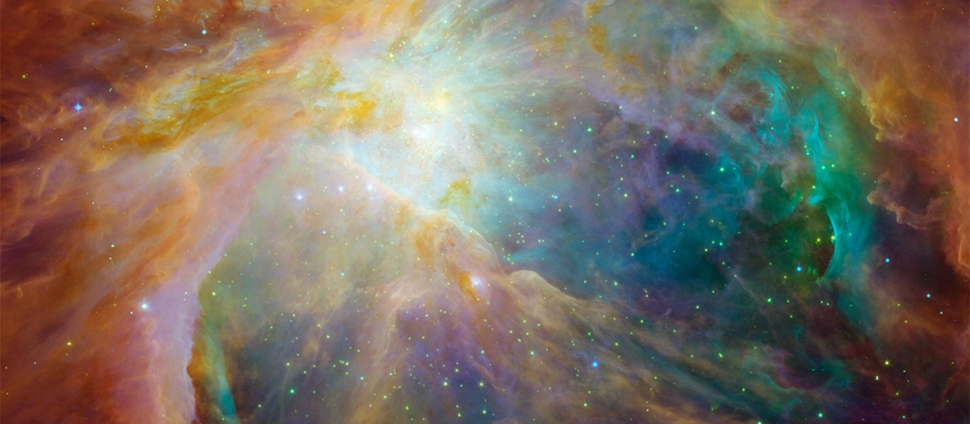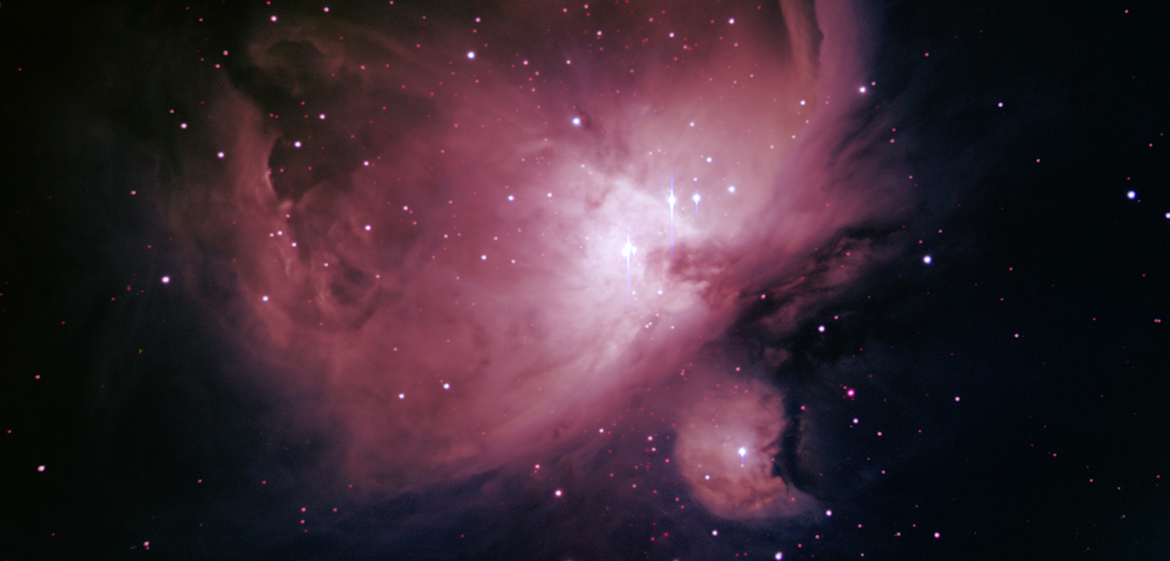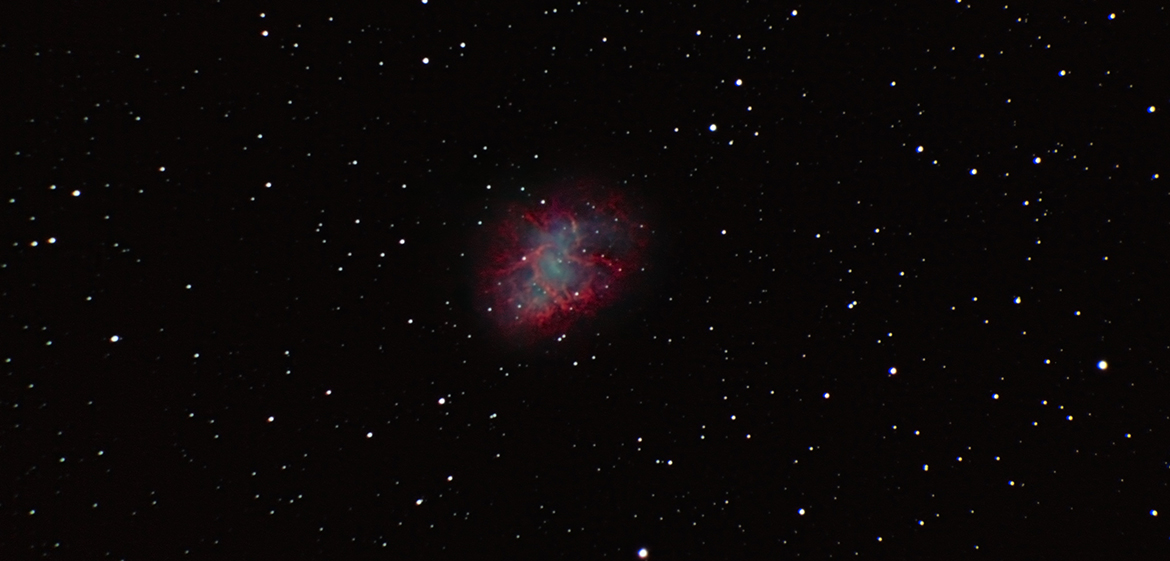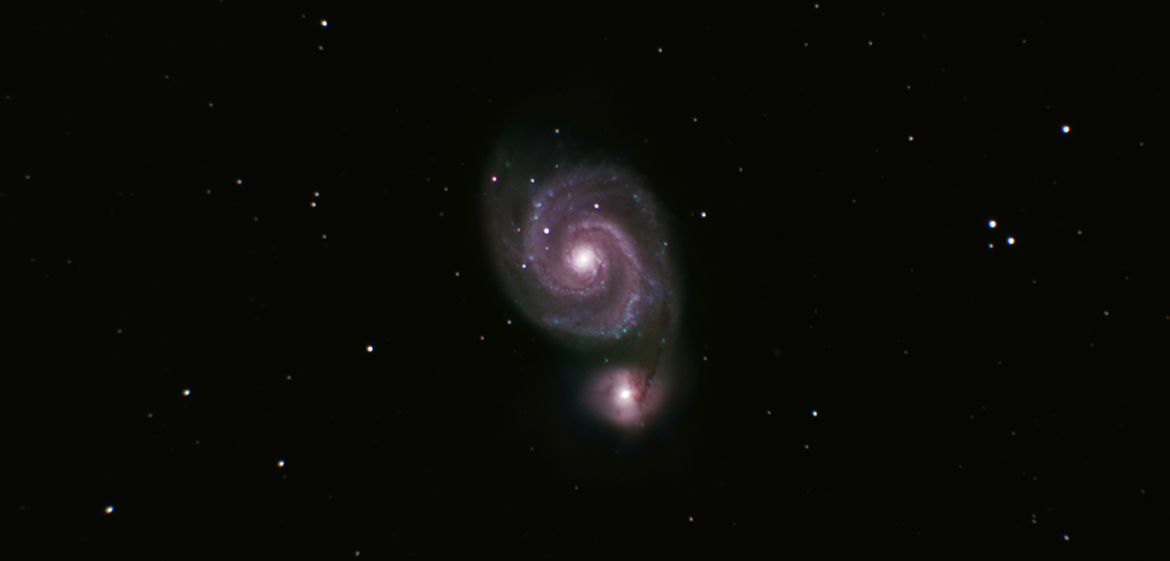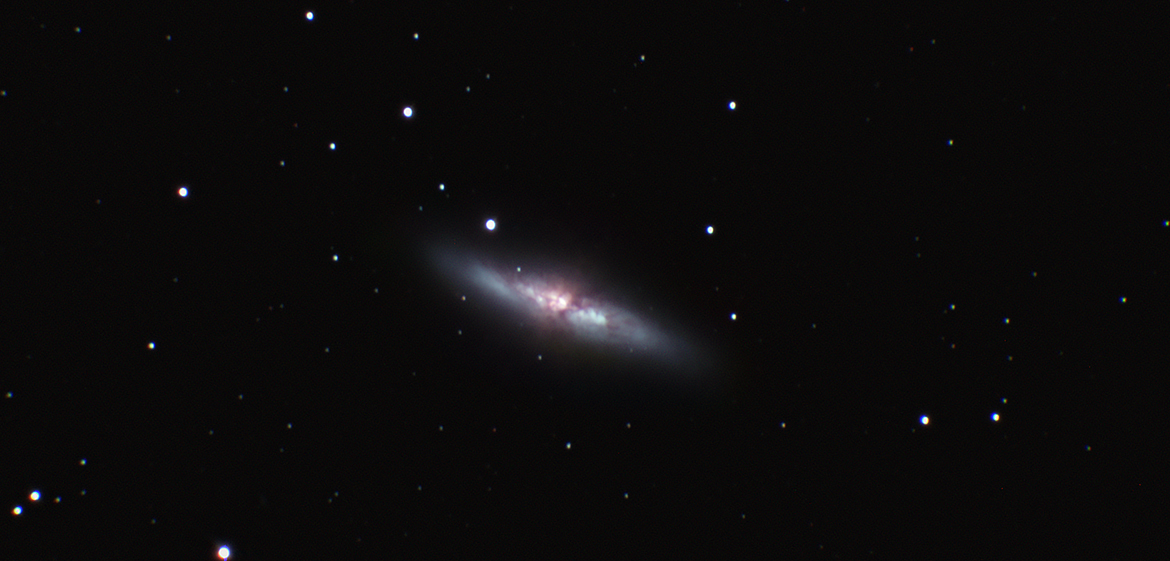Smith astronomy is a part of the Five College Astronomy Department. The consortium offers a rich curriculum in astronomy and astrophysics, taught by astronomers from Smith, Amherst College, Hampshire College, Mount Holyoke College and the University of Massachusetts. Students who major in astronomy also take courses in physics and often double major in physics and astronomy.
Astronomy is the study of the cosmos, from our home planet to the farthest reaches of the universe. One of the original liberal arts, astronomy offers an unparalleled perspective for appreciating our planet and the life that it supports. It also provides an opportunity to appreciate the simplicity of the forces of nature and understand how these forces govern the origin and evolution of our universe.
- Be an active learner/researcher; be able to recognize and define important questions and know how to go about finding the answers.
- Be familiar with basic concepts from physics and astronomy, including gravity, the nature of light and physical characteristics of matter, and be able to use them as the basis for critical reasoning.
- Be skilled at quantitative problem solving incorporating hypothesis formation, data analysis, error analysis, conceptual modeling, numerical computation and hypothesis testing through quantitative comparison between observation and theoretical concepts.
- Be familiar with scientific instrumentation used by professional astronomers.
- Be familiar with digital imaging as a source of scientific data, including techniques of acquisition, reduction and analysis.
- Demonstrate use of critical thinking skills in well-organized, logical and scientifically sound oral and written scientific reports.
- Be able to critically evaluate representations of science in the media, both in writing and in speaking.
- Be able to communicate science effectively to the general public and the media.
- Be aware of and prepared for the variety of opportunities and career paths that are open to students who have majored in astronomy.
Advisers: James Lowenthal, Kim Ward-Duong
The astronomy major is designed to provide a good foundation in modern science with a focus on astronomy. Taken alone, it is suited for students who wish to apply scientific training in a broad general context. If coupled with a major in physics, the astronomy major provides the foundation to pursue a career as a professional astronomer. Advanced courses in mathematics and a facility in computer programming are strongly encouraged.
Many astronomy majors conduct independent research projects, experiencing both the discipline and the excitement of making astronomical discoveries. Recent senior thesis projects “Studying Accretion and Winds in Young Stars with Spectroscopy” by Jenny Podel ’14 and “Revisiting Forbidden Lines in T Tauri Stars,” by Wanda Feng ’15 won the Five College Astronomy Mary Dailey Irvine Prize for best undergraduate thesis, and “Worlds Beyond: Follow-up Observations and Confirmation of K2 Exoplanet Candidates” by Rachel O’Connor ’18 won the Chambliss Student Award from the American Astronomical Society.
Requirements for the Major
Eleven courses (44 credits), which will normally include the following 8 courses:
- 100 or 111*
- 113
- Three astronomy courses at the 200 level, including 228
- One astronomy course at the 300 level
- PHY 117 and 118
- Three additional courses at 200/300 level**
*Students with especially strong background in physics or astronomy may, in consultation with your adviser, replace 111 with a more advanced course
** Up to two of the additional three courses may, after consultation with and approval by your adviser, be selected from 200 or 300 level courses in a related discipline such as mathematics, physics, geology, computer science, or the history or philosophy of science.
Advisers: Suzan Edwards, James Lowenthal
The astronomy minor is designed to provide a practical introduction to modern astronomy. If combined with a major in another science or mathematics-related field, such as geology, chemistry or computer science, it can provide a versatile scientific background, which prepares students for future work as scientists or technical specialists. Alternatively, the minor may be combined with a major in a nonscientific field, such as history, philosophy or education; for students who wish to apply their astronomical backgrounds in a broader context, that could include the history of science, scientific writing or editing, or science education.
Requirements for the Minor
The requirements for the minor in astronomy are 24 credits (6 courses), including:
- 100 or 111 or the equivalent
- Any 200-level astronomy course
- PHY 117 or 118
- 3 additional astronomy courses or 2 astronomy and 1 physics course
Advisers: Suzan Edwards, James Lowenthal
The astrophysics minor is another possible route for a student who is considering a career as a professional astronomer. Central to this approach is a strong physics background, coupled with exposure to topics in modern astrophysics. Students are advised to acquire a facility in computer programming. Especially well-prepared students may enroll in graduate courses in the Five College Astronomy Department.
Requirements for the Minor
- Completion of physics major
- Any three astronomy classes, excluding 100, 102 or 103
Introductory courses include those for a broad audience (100, 102, 103) and for science/math majors (111, 113). Meeting times and locations for courses for the current semester can be found in the Course Search tab in the online Smith Course Catalog.
100 Survey of the Universe
Discover how the forces of nature shape our understanding of the cosmos. Explore the origin, structure, and evolution of the earth, moons and planets, comets and asteroids, the sun and other stars, star clusters, the Milky Way and other galaxies, clusters of galaxies and the universe as a whole. Designed for non-science majors. 4 credits.
102 Sky I: TIME
Explore the concept of time, with emphasis on the astronomical roots of clocks and calendars. Observe and measure the cyclical motions of the sun, the moon, and the star, and understand phases of the moon, lunar and solar eclipses and seasons.Designed for non-science majors. Enrollment limited to 25 per section. 4 credits.
103 Sky II: Telescopes
View the sky with the telescopes of the McConnell Rooftop Observatory, including the moon, sun, planets, nebulae and galaxies. Learn to use a telescope on your own, and find out about celestial coordinates and time-keeping systems. Designed for non-science majors. Enrollment limited to 20 students per section. 3 credits.
111 Introduction to Astronomy
A comprehensive introduction to the study of modern astronomy that explores the celestial bodies that inhabit the universe—planets, stars and galaxies—and examines the universe itself—its origin, structure and ultimate destiny. Designed for students who are comfortable with mathematics. Prerequisite: MTH 102 or the equivalent. 4 credits.
113 Telescopes and Techniques
An introduction to observational astronomy for students who have taken or are currently taking a physical science class. Become proficient using the telescopes of the McConnell Rooftop observatory to observe celestial objects, including the Moon, the Sun, the planets, stars, nebulae and galaxies. Learn celestial coordinate and time-keeping systems. Find out how telescopes and digital cameras work. Take digital images of celestial objects and learn basic techniques of digital image processing. Become familiar with measuring and classification techniques in observational astronomy. Not open to students who have taken AST 103. Enrollment limited to 20 students. 4 credits.
Meeting times and locations for courses for the current semester can be found in the Course Search tab in the online Smith Course Catalog or, for those 200/300 level courses taught off campus in the Five College Astronomy Department, in the Five College Course Listing.
214 Astronomy and Public Policy
This seminar explores the intersection of physical science, social science, psychology, politics and the environment. We focus on three topics with close ties to astronomy: (1) global climate change, which involves basic atmospheric physics; (2) light pollution, which wastes billions of dollars per year and ruins our view of the starry sky without providing the safety it promises; and (3) controversial development of mountaintop observations such as the Thirty Meter Telescope on Mauna Kea, HI. Includes theater improvisation techniques to hone science communication skills. Prerequisite: one college science course in any field. 4 credits.
220 Special Topics in Astronomy
Recent topics include astronomy and public policy, asteroids, and the art of communicating science through electronic media. The current topic is Explosions in Astrophysics. Prerequisite: one science course in any field. 4 credits.
223 Planetary Science
An introductory course for physical science majors. Topics include: planetary orbits, rotation and precession; gravitational and tidal interactions; interiors and atmospheres of the Jovian and terrestrial planets; surfaces of the terrestrial planets and satellites; asteroids, comets and planetary rings; and origin and evolution of the planets. Prerequisites: one semester of calculus and one semester of a physical science. 4 credits.
224 Stellar Astronomy
Discover the fundamental properties of stars from the analysis of digital images and application of basic laws of physics. Extensive use of computers, scientific programming and data analysis. Prerequisites: PHY 115, MTH 111, plus one astronomy class. 4 credits.Alternates with AST 225.
225 Galaxies and Dark Matter
The discovery of dark matter and the role of gravity in determining the mass of the universe is explored in an interactive format making extensive use of computer simulations and independent projects. Prerequisites: PHY 115, MTH 111, plus one astronomy class. 4 credits. Alternates with AST 224.
226 Cosmology
Cosmological models and the relationship between models and observable parameters. Topics in current astronomy that bear upon cosmological problems, including background electromagnetic radiation, nucleosynthesis, dating methods, determinations of the mean density of the universe and the Hubble constant, and tests of gravitational theories. Discussion of some questions concerning the foundations of cosmology and its future as a science. Prerequisites: MTH 111 and one physical science course. 4 credits.
228 Astrophysics I: Stars and Galaxies
A calculus-based introduction to the properties, structure, formation and evolution of stars and galaxies. The laws of gravity, thermal physics and atomic physics provide a basis for understanding observed properties of stars, interstellar gas and dust. We apply these concepts to develop an understanding of stellar atmospheres, interiors and evolution, the interstellar medium, and the Milky Way and other galaxies. Prerequisites: two semesters of college-level physics (concurrent enrollment is acceptable) and second-semester calculus. 4 credits.
Meeting times and locations for courses for the current semester can be found in the Course Search tab in the online Smith Course Catalog or, for those 200/300 level courses taught off campus in the Five College Astronomy Department, in the Five College Course Listing.
330 Seminar: Topics in Astrophysics
In-class discussions focus on formulating a set of problems, each designed to illuminate a significant aspect of the topic at hand. The problems will be significant in difficulty and broad in scope: their solution, worked out individually and in class, will constitute the real work of the course. Students will gain experience in both oral and written presentation. Topics vary from year to year. Recent topics include Mars, the moon, and cosmology and galaxy formation. Prerequisite depends on topic. 4 credits.
335 Astrophysics II: Stellar Structure
Direct determinations of distances in the solar system and to nearby stars. Indirect measurements of the distances to more distant stars and galaxies. Celestial mechanics, interactions of radiation with matter, thermal radiation, stellar structure, formation of spectral lines and stellar pulsation. Prerequisites: AST 228 plus 4 semesters college physics. 4 credits.
337 Observational Techniques I
An introduction to the techniques of gathering and analyzing astronomical data, with an emphasis on observations related to determining the size scale of the universe. Telescope design and optics. Instrumentation for imaging, photometry and spectroscopy. Astronomical detectors. Computer graphics and image processing. Error analysis and curve fitting. Prerequisites:at least one of AST 224, 225 or 228, 2 semesters of physics and 2 semesters of calculus. 4 credits.
341 Observational Techniques II
An immersive research experience in observational astrophysics for students who have completed AST 337. Students design an independent scientific observing program and carry it out at the WIYN 0.9m telescope on Kitt Peak, AZ in January. The rest of the semester is spent reducing and analyzing the data obtained and preparing scientific results for presentation. Professional techniques of CCD imaging, photometry, astrometry and statistical image analysis are applied using research-grade software. Weekly class seminar meetings are supplemented by individual and team-based tutorial sessions. Possible projects include studying star formation regions and star formation histories in external galaxies, measuring ages and chemical composition of star clusters, searching for exoplanets, supernova or eclipsing binary stars. Prerequisites: AST 337 and permission of the instructor. Enrollment limit of 10 students, 4 credits
352 Astrophysics III: Galaxies and the Universe
The application of physics to the understanding of astronomical phenomena related to galaxies. Dynamics and structure of stellar systems: the virial theorem and Jeans' equations and their applications; galaxy rotation and the presence of dark matter in the universe; and spiral density waves. The stellar content of galaxies, including star formation and the principle of stellar population synthesis. Physical processes in the gaseous interstellar medium: photoionization and HII regions and emission lines; shocks in supernova remnants and stellar jets; and energy balance in molecular clouds. Quasars and active galactic nuclei: synchrotron radiation; accretion disks; and supermassive black holes. Students are involved in the course in discussion, oral presentations and lab projects. Prerequisites: four semesters of physics beyond PHY 118.
400 Special Studies
Independent research in astronomy. Admission by permission of the department. The student is expected to define her own project and to work independently under the supervision of a faculty member. 1 to 4 credits.
Faculty
The telescopes of the McConnell Rooftop Observatory (latitude 42:19:02 N, longitude 72:38:22 W) at the Clark Science Center are in use by students every clear night during the academic year and in public stargazing sessions each semester. We have four courses dedicated to astronomical observing with telescopes: AST 103, AST 113, AST 337, AST 341.
Our two large computer-controlled telescopes, each in separate housing with permanent mounts, are a 16-inch Meade LX200 ACF Schmidt-Cassegrain and a 12-inch Meade LX200 Schmidt-Cassegrain. We have a portable 10-inch Meade RCX 400, kindly donated by Aimee Girard ’10. Our latest addition is a 10-inch Dobsonian Newtonian telescope, a generous gift from Mr. Barry Sussman. We also have eight portable 8-inch Schmidt-Cassegrain telescopes that can be set up on rooftop-observing platforms, and another eight at the MacLeish Field Station in Whately. Our instrumentation for data acquisition includes two 2K x 3K SBIG CCD cameras with standard UBVRI sets of astronomical filters for color imaging and seven Canon DSLR cameras for astrophotography, funded in part by a gift from John Hayward in honor of Jo Ann Lord Hayward ’51.
For solar viewing we have the Lisa Abrams ’90 Coronado SolarMax 90 scope, equipped with a special red filter for viewing flares and erupting prominences through the light of hot hydrogen gas, along with a pair of Coronado Personal Solar Telescopes with a red hydrogen and a blue calcium filter.
We have guaranteed observing time on the WIYN 0.9m telescope at Kitt Peak National Observatory in Arizona, used for student observing both in AST 341 and for independent research. Other FCAD telescopes include the Amherst College Wilder Observatory, with an 18-inch refractor; the UMass Orchard Hill Observatory 16-inch; and the Williston Observatory 24-inch reflector at Mount Holyoke.

Public Stargazing Sessions
Join us to see stars, planets, galaxies and nebulae at the McConnell Rooftop Observatory!
Call 413-585-3935 if you have questions or special needs, or to check if an event is cancelled due to inclement weather. Every child under 8 should be accompanied by an adult. Remember to dress warmly.
Spring 2023 Semester
Stargazing sessions are held 8:30-9:30 pm. Schedule:
Thursday, February 23 - CANCELLED
Friday, March 3
Friday, March 24 - CANCELLED
Thursday, March 30
Thursday, April 20
Thursday, May 4
Image Gallery
Images taken with our 12- and 16-inch telescopes.
Resources
Summer Opportunities
Career Options in Astronomy
- Career Advice from the American Astronomical Society
- Career Advice on Being an Astronomer from the National Optical Astronomy Observatories
- American Astronomical Society Career Services
- American Institute of Physics Student Programs
- Graduate Programs in Astronomy
- American Association of Physics Teachers Scholarships for Future Teachers
Literature Searches
Tools & Software
- Calculators and Conversions
- A Guide to IDL for Astronomers
- Image Reduction and Analysis Facility (IRAF)
- Flexible Image Transport System (FITS)
- Ned Wright's Cosmology Calculator
- Lionel Siess Homepage, Stellar Evolution
- Gemini Observatory: Conversion from Magnitudes to Flux
Journals
Catalogs, Surveys and Archives
- Hubble MAST Archive
- CDS/ESA VizieR Catalogue Service Home Page
- SIMBAD Astronomical Database
- Sloan Digital Sky Survey
- The Two Micron All Sky Survey at IPAC
Spectroscopy
- The Atomic Line List (University of Kentucky)
- Energy Levels, Wavelengths, Transition Probabilities
- Kurucz Atomic Line Database
- NIST Atomic Spectra Database
- NIST Atomic Transition Probability Bibliographic Database
- NIST Handbook of Basic Atomic Spectroscopic Data
- NIST Ground Levels and Ionization Energies for Neutral Atoms
Time
- NIST: A Walk Through Time
- U.S. Naval Observatory Master Clock
- Official U.S. Time
- Local Sidereal Time
Earth, Sun, Moon, Planets
- Local Cloud Cover: Infrared Satellite Image
- Clear Sky Clock
- Northampton Weather Forecast from NOAA
- Northampton AccuWeather
- Astronomical Information Center USNO
- The Moon's Phase
- Moon Phase Calendar from Moon Connection
- Moon Phase Calendar from Stardate
- Earth and Moon Viewer
- Rise/Set for Sun, Moon, Planets from Farmer's Almanac
- The Naked Eye Planet in the Night Sky
The Sky
- This Week's Sky at a Glance From Sky & Telescope
- StarDate (UT)
- Night Sky from Space.com
- Tonight's Sky (Hubble Space Telescope)
- Astronomy magazine
- Tonight's Sky Chart From Sky and Telescope
- The Constellations (Dibon-Smith)
- The Constellations and their Stars
- The Constellations
- Stars (Kaler)
- Finding Your Way Around the Sky
- Your Sky
Telescope Observing
- Double Stars from Sky & Telescope
- Top 200 Most Beautiful Double Stars (Coldfield Observatory)
- Double Star Club, Astronomical League
- Double Stars, Eagle Creek Observatory
- Star Clusters from Messier Catalog (SEDS)
- Open Clusters (Atlas of Universe)
- Planetary Nebulae (Atlas of Universe)
- Diffuse Nebulae (Atlas of Universe)
- 111 Deep Sky Wonders for Light-Polluted Skies (Sky & Telescope)
- Deep Sky (Sky & Telescope)
- Messier Listing (Hawaiian Astronomical Society)
- Telescope Guide
Sky Legends
Cultures
Contact
Email: jlowenth@smith.edu
Department Chair: James Lowenthal
Individual appointments can be arranged directly with the faculty.

